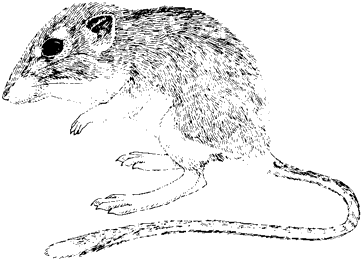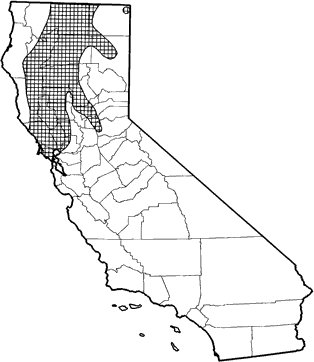
California Kangaroo Rat
Distribution, Abundance, and Seasonality
In California, occurs from the Oregon border (Siskiyou and Modoc cos.) south to San Francisco Bay, and in the Sacramento Valley and Sierra Nevada foothills from El Dorado Co. north. Inhabits open areas, generally below 400 m (1310 ft) elevation, but found as high as 1300 m (4270 ft) in Shasta Co. Usually found in annual grassland habitat, but also occurs in clearings in mixed chaparral habitat on the lower slopes of foothills (Verner and Boss 1980).

Range Map
Specific Habitat Requirements
Feeding: Feeds on the seeds of grasses, forbs, and shrubs. Forbs, and other leafy vegetation, eaten seasonally. Cheek pouch contents of individuals from Oregon included berries and seeds of manzanita, ceanothus, rabbitbrush, lupine, burclover, wild oats, and small tubers (Verner and Boss 1980).
Cover: Burrows excavated in loose soils, often at bases of shrubs or edges of rocks. Where sandy soils are lacking, burrows may be excavated in spring, when soil is wet. Sands or silts required for dust bathing.
Reproduction: No data found.
Water: Water apparently obtained metabolically from food and from moisture in food.
Pattern: Open annual grassland to mixed chaparral preferred. Also present in valley foothill hardwood, and to a lesser extent in valley foothill hardwood-conifer habitats.
Species Life History
Activity Patterns: Active yearlong, nocturnally.
Seasonal Movements / Migration: None.
Home Range: No data found. Kangaroo rats are aggressively solitary.
Territory: No data found.
Reproduction: Breeds February through September, with peak February through April (Kelt 1988). There are 2-4 young per litter.
Niche: Predators include foxes, owls, and snakes (Kelt 1988).
Comments: Grinnell (1922) and Hall (1981) considered this species to be composed of 3 subspecies of D. heermanni. Biochemical and morphological evidence support the specific status of D. californicus (Patton et al. 1976). Therefore, inferences on the biology of D. californicus that are based on studies of D. heermanni may be invalid.
Sources & References
California Department of Fish and Game, 1999.
California's Wildlife, Sacramento, CA.
Written by: P. Brylski, reviewed by: H. Shellhammer, edited by: R. Duke
Grinnell, J. 1922. A geographical study of the kangaroo rats of California. Univ. Calif. Publ. Zool. 24:1-124. Hall, E. R. 1981. The mammals of North America. Second ed. 2 Vols. John Wiley and Sons, New York. 1271pp. Kelt, D. A. 1988. Dipodomys californicus. Mammal. Species No. 324. 4pp. Patton, J. L., H. MacArthur, and S. Y. Yang. 1976. Systematic relationships of the four-toed populations of Dipodomys heermanni. J Mammal. 57:159-163. Verner, J., and A. S. Boss. 1980. California wildlife and their habitats: Western Sierra Nevada. USDA, For. Serv. Gen. Tech. Rep. PSW-37. 439pp.
California Animal Facts | California's Wildlife